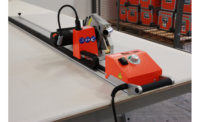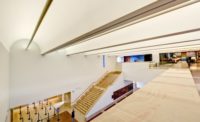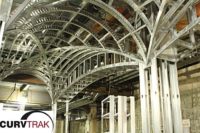Think you can’t teach old dogs new tricks? Well, sometimes you can. Think you can’t finish an interior frame job 25 percent faster than usual? Sometimes you can do that, too. And, on a really good project, sometimes you can do both. At least if you are Cheyne Jackson you can.
It’s true. Jackson, an estimator and project manager for Jackson Quality Drywall of Minden, Nev., did just that on the recent Northern Nevada HOPES community health center construction project in downtown Reno, Nev. Initially the three-story job was bid using industry standard metal stud framing that included a bottom track, slotted deflection track, and a full-length metal stud that would screw in at the top and bottom. It would have done just fine; however, Jackson had recently worked with an alternative framing system he thought might work even better for Northern Nevada HOPES. He was spot on.
The system he wanted and ultimately used was ClarkDietrich’s TRAKLOC Drywall Framing System, which can telescope or adjust in length according to variances in the slab. This means contractors can order one length member for the entire project and easily adjust its size as needed without having to stop, measure and cut each stud. This translates into very real time savings for crews, which ultimately means more profits for the install team. Plus, contractors face none of the safety hazards that come with cutting steel studs and they don’t have to fool with nearly as many screws either.
“This is the second time we’ve used TRAKLOC, and have had success both times. It’s been a major labor savings for us. The less time we spend building something, the more profitable we can be. Plus, it helps the general contractor out with the schedule. We get our work done faster so the trades get to fall in right behind us,” Jackson says.
Action Jackson
Everett VanCampen, construction superintendent with The Neenan Co. of Fort Collins, Colo., also has had success using the product. This was the first time he had used the system and is pleased with what he saw. “I think it’s a good system. I like the way it works,” he says.
VanCampen explained that many of the installers had to undergo a training process to learn how to use TRAKLOC since several, like himself, were unfamiliar with the system. “Even still it was faster than conventional framing,” he observes.
Because this was only the second time Jackson had worked with the telescoping studs and the first time for most of his crewmembers, he acknowledges there was an initial learning curve to overcome. In fact, most of his contractors have been in the industry for years, some a quarter of a century, so the new framing system took a little getting used to. The crew took time during the weekly safety meetings to learn the system, and found that it was quite easy to learn.
“Once you get set in a way of doing something, it can be hard to teach a dog new tricks. But you can, even with new technologies and construction practices,” Jackson says. Obviously, his crew was quick to adjust.
All told, the job required 60,000 linear feet of the telescoping stud system. Between two and three crews of two men, deflection studs were installed for floors one and two. The first floor was framed in one week and the second floor was done in three weeks on account of the number of small offices in that space. Floor three, which required elevator studs, took a crew of two men two weeks to complete. The teams easily kept up with the other trades on site.
While the first two floors were constructed with straight measurements, the third floor was not. This floor, which was also the top floor in the building, was a challenge because the roof sloped to drain rainwater, which in turn caused a significant variation in the deck height.
“I ended up using an elevator stud, which you typically use in high rise buildings. We collapsed the members to eight feet and expanded as needed. This really helped us out because we did not have to cut every single stud,” Jackson says.
While the third-floor crew had to screw the top of each member into a slotted deflection track, they saved an immense amount of labor by not having to cut every stud. Nor did they have to screw the bottom of each stud into the track. They simply had to twist and snap them into place.
In the end, Jackson says his crew completed the third-floor install nearly 20 percent faster than originally estimated when the work called for traditional steel studs. The first and second floors were framed an impressive 25 to 30 percent faster.
Jackson says he intends to use the framing system for more jobs down the line. In fact, he’s already eyeing it for the next job he’s been awarded.









Report Abusive Comment